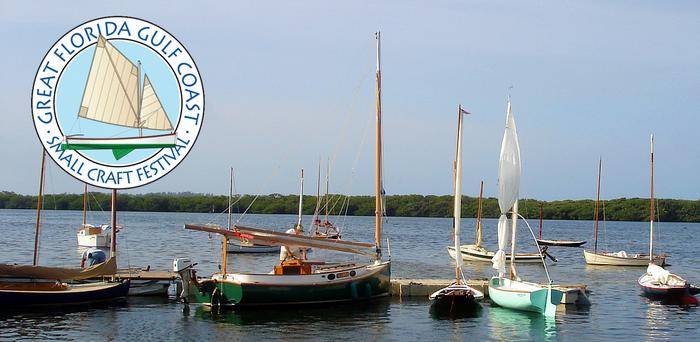
The late afternoon waterfront was still and flesh-warm. Only broken by the splash of a jumping mullet or the sudden outburst from a seagull, the glassy waterscape seeped Old Florida. Wooden docks askew from storms and time kept silent fishing boats bowing slowly to their slack moorings. This was, and is, the fishing village of Cortez, Florida. I stood with Matt Hanks on an old floating dock looking out over the panorama and letting the tension of a four and a half hour drive ease away. We were there to bring the good news of our lighthouse boatbuilding program to the Gulf coast, to learn about what other programs are doing, and to show off the William A. Harn, the first boat built by LAMP Boatworks. Follow along to learn more about LAMP Boatworks and the Florida Gulf Coast Small Craft Festival!
Cortez, like St. Augustine, has a vibrant maritime history and the Florida Maritime Museum in Cortez is a centerpiece for this unique past. The museum, like the St. Augustine Lighthouse & Museum, also has a boatbuilding program. Theirs, unlike ours, supports full time boatbuilders, and their program has launched a number of wonderful craft as well as performing restoration work. Combined with their local chapter of the Traditional Small Craft Association, each year they host the Small Craft Festival to gather traditional craft from all over the state and the nation. The TSCA has been an active advocate for builders and restorers of traditional boats. Unlike many modern designs, traditional watercraft are often the boats that attract our eyes to their appealing lines and painstaking craftsmanship. It can be said with certainty that traditional craft carry with them not only an aesthetic that we love to caretake, but a history that is vital for us to steward. Without them, how would Columbus (or Pedro Menendez, for that matter!) have stepped ashore from his ship? How would John Smith have mapped the Chesapeake Bay, the world’s greatest estuary and cradle for English colonization, without his shallop? How too, would indigenous populations of the Americas and Pacific islands, accomplished to much to explore and populate remote regions and isles? And so the small watercraft, often relegated to Sunday picnicking, takes on a much more weighty historic burden. But, I meander from Cortez.
As those of you who have been participating, listening, and reading know, LAMP Boatworks has been busy over the past four years. Not only have we grown a boatbuilding program from nothing, but LAMP Boatworks has achieved Coast Guard builder’s certification and is now completing its eighth hull. For a program that is solely volunteer-run and operates for three half-days each week, LAMP Boatworks has been busy and productive. Once only a seed in the mind of Dr. Sam Turner, LAMP Director of Archaeology, LAMP Boatworks is now involved in no less than two in-house building projects, two tallship-related projects spanning two continents, has built two boats for other museums, and continues historical research to keep alive the story of our maritime past. And so, with this in mind, Matt and I ventured forth to take our show on the road.
After arriving and registering at the old general store, we surveyed the town on Friday night, taking in the dock scene and enjoying some seafood at the infamous Cortez Kitchen. Saturday morning began early and we arrived not long after sunup to launch the Harn and set up our display. Using a small tidal creek, we picked up the boat and slid it down the grassy bank into the water. After loading the boat with its rig, Matt and I slogged the skiff up the creek until we had enough water to float the boat fully loaded. We hopped in and poled our way through a sun-filtered cathedral of a black mangrove. The branches met over the stream, making a tunnel of leaves and branches. Egrets and herons were profuse and voiced their guttural squawks of displeasure over having to share their arboretum. The clear water around us, growing in width and depth as we neared the mouth of the freshet, revealed schools of minnows and other small fish with a clarity rarely seen on the First Coast.
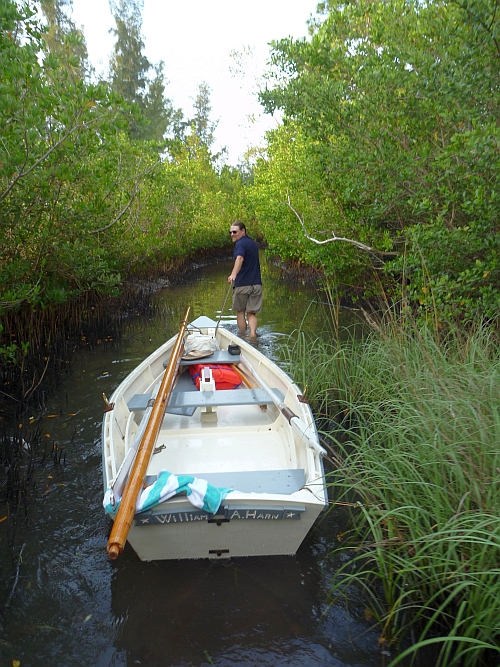
Hauling the skiff down the creek to the docks.
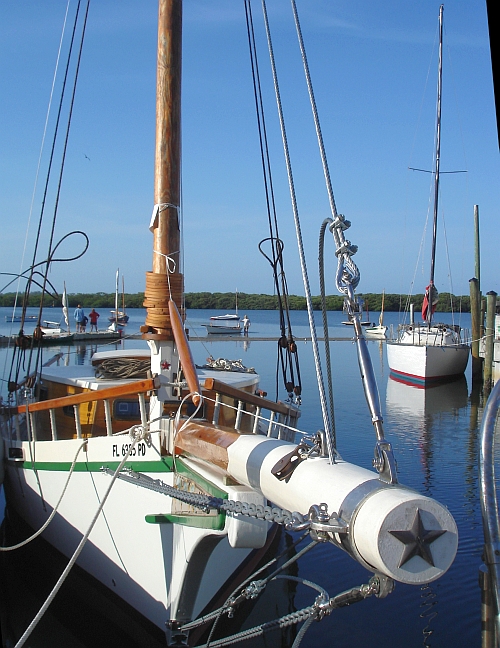
A newly launched skipjack at the docks, a jewel of the show.
Matt and I emerged onto the small embayment of Cortez’s working waterfront. Docking the boat, we set up the mast and began the process of rigging her for action. Bending the sail on the mast, we secured it snugly as a fresh wind began to blow out of the west. We used to boom like a sprit to hold the LAMP Boatworks banner and a full size US Light Service pennant. The big pennant luffed and snapped in the breeze like a runaway sail and attracted attention to our little display. Many other boats surrounded us and varied greatly in color, style, and rig. From beautiful melon seed’s to a replica of Col. Munroe’s schooner rigged sharpie Egret, the boats offered quite a beautiful vista. A series of floating docks were rigged around, and over a shallow sandbar so that the boats on anchor out from the dock could be reached, even at high tide, by wading shin-deep out to them. This arrangement was ingenious and plenty of conversations were held throughout the day knee-deep on the bar, surrounded by anchored craft.

The best sort of work meeting.
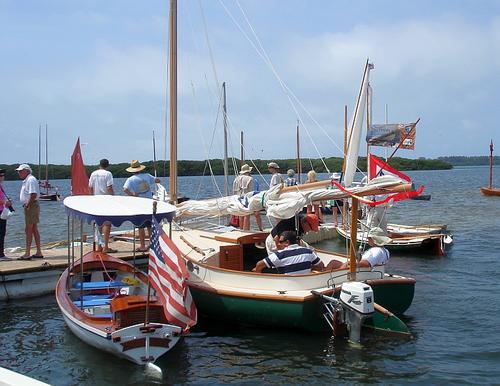
The festival dock.
Matt and I, wearing our LAMP polo shirts, stood out a little from the crowd and were asked plenty of questions throughout the day. As I suspected, many people had no idea that the St. Augustine Lighthouse & Museum has a boatworks, moreover a maritime archaeology program! After the regatta was over and the events of the day began to wane a little, we down-rigged the display banner and unfurled the sail. It was time for the Harn to stretch its legs. We clawed our way out the little channel and into the bay, dropped the daggerboard, and let the sail fill. For the next hour or so, we tacked and wore around Cortez and let the boat work a little. Boats, wooden boats in particular, need working. A boat just sitting on exhibit can deteriorate in ways that you will never know unless you put it in the water and row it, sail it, or motor it. Repairs can then be effected in order to ‘keep alive’ the craft and ensure its longevity. A simple Newtonian principle, ‘An object in motion tends to stay in motion.’
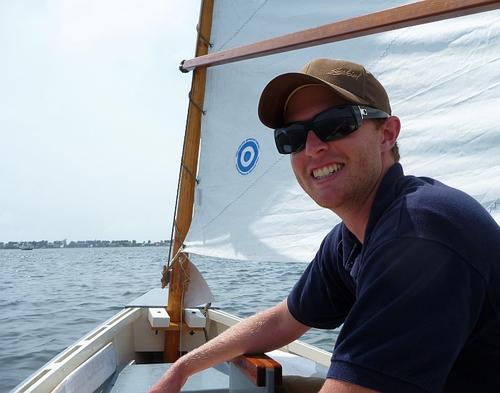
Matt Hanks, LAMP Intern, a quick study at the helm and now a proficient sailor.
Saturday evening Matt and I attended the banquet and annual TSCA national meeting. Enjoying fresh local grouper, we sat with Ryan Murphy, the director of the Florida Maritime Museum and a slew of other wonderful enthusiasts, master builders, and preservationists. I wish I could relate all of their names and backgrounds but if you were there and read this let me know and I’ll properly cite our table roster! Having a later evening engagement over in Ana Maria Island at a concert, Matt and I departed after the meeting. Sunday morning we returned to the docks, where we had left our boat with the rest securely tied up overnight and re-rigged to sail. The day’s schedule was simple: take your boat our, or borrow someone else’s, and sail. We did just that and Matt, not having ever been on a sailboat before, became quite a proficient sailor. Enjoying the cerulean waters of the Gulf Coast and the warm weather, we put several miles under the keel before returning to downrig and depart. Later that afternoon, with a belly full of fresh fish and fried okra, we poled back up the little creek and hauled the boat out. Five hours later we were back in St. Augustine, happy but sunburned!
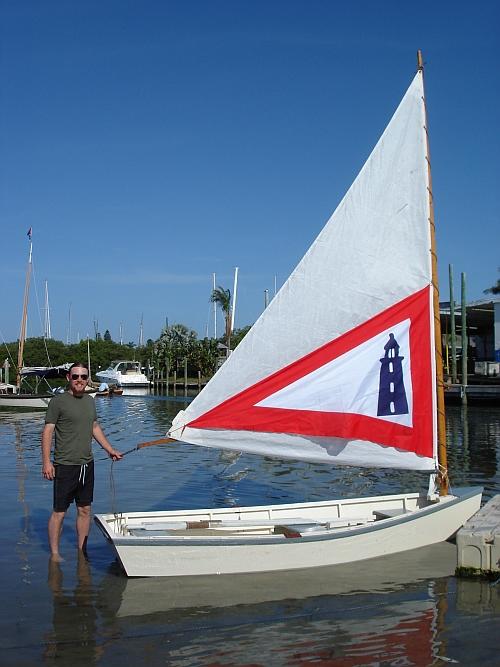
Brendan with the William A. Harn.
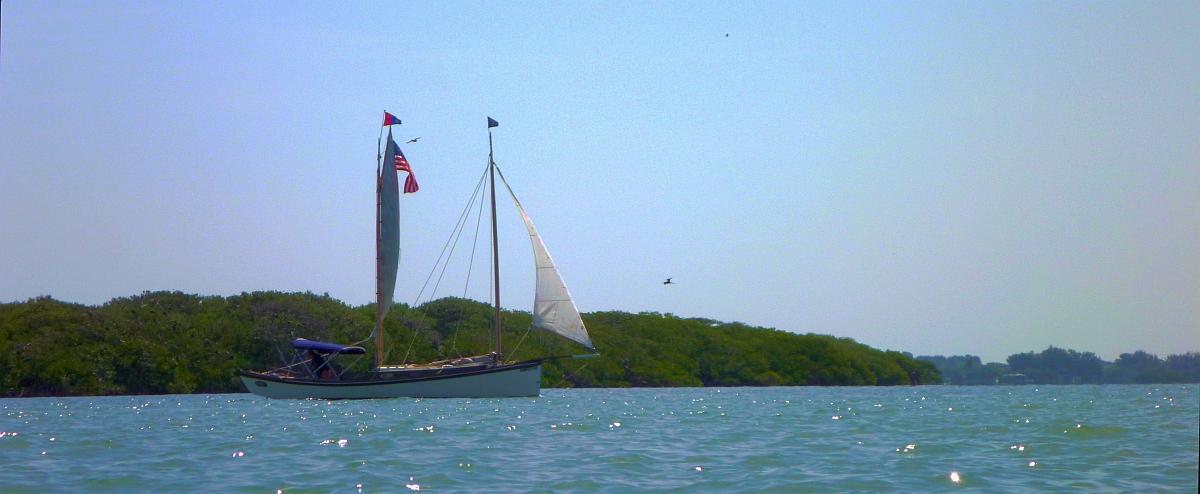
A beautiful rendition of Egret, Col. Munroe’s sharpie from the early 20th century.
I encourage you all to attend events like the Florida Gulf Coast Small Craft Festival. Not only do they support museums and organizations that keep the traditions alive, but small craft gatherings are just plain fun. We felt too that, it was time for LAMP Boatworks to get its name out and about and talk with other builders about their boatworks as well as showing off a little of what we’re doing here. The William Harn may be a kit boat, and not the most complex or aesthetically pleasing watercraft but she’s ours, our number one hull, and a heck of a fine skiff for sailing, rowing, and showing. I want to thank the Florida Maritime Museum in Cortez for hosting this event as well as the Florida Gulf Coast chapter of the Traditional Small Craft Association, Ryan Murphy, Bob Pitt, Ted Adams, Roger Allen, and many, many more folks who made the event successful and fun!
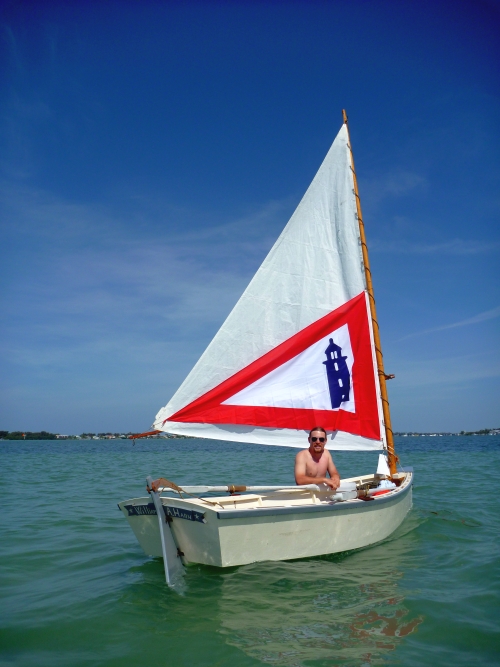
Look at that clear water!!
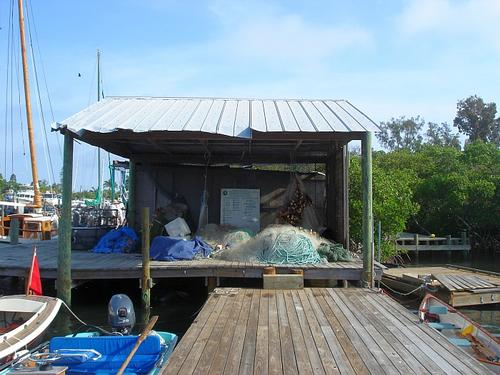
Nice to see a real working waterfront.

Stone crab pots stacked under a net shed.
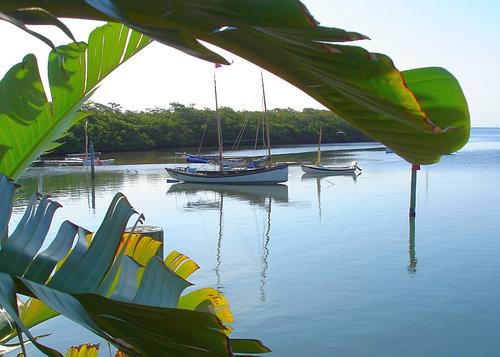
Sunday morning at the festival.

